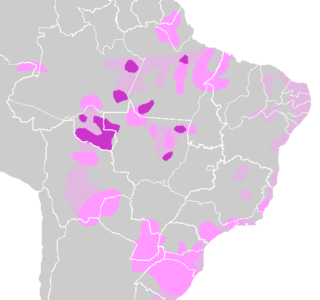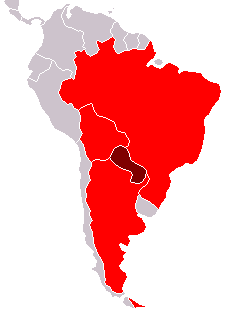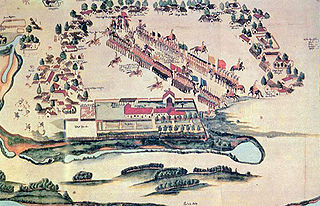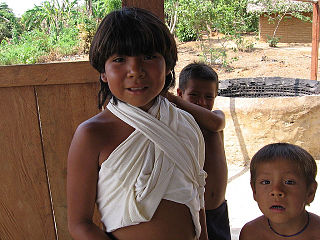The Awá are an indigenous people of Brazil living in the Amazon rain forest. There are approximately 350 members, and 100 of them have no contact with the outside world. They are considered highly endangered because of conflicts with logging interests in their territory.

Guarani are a group of culturally-related indigenous peoples of South America. They are distinguished from the related Tupi by their use of the Guarani language. The traditional range of the Guarani people is in present-day Paraguay between the Paraná River and lower Paraguay River, the Misiones Province of Argentina, southern Brazil once as far east as Rio de Janeiro, and parts of Uruguay and Bolivia.

Tupi–Guarani is the most widely distributed subfamily of the Tupian languages of South America. It consists of about fifty languages, including Guarani and Old Tupi.

Old Tupi, Ancient Tupi or Classical Tupi is an extinct Tupian language which was spoken by the aboriginal Tupi people of Brazil, mostly those who inhabited coastal regions in South and Southeast Brazil. It belongs to the Tupi–Guarani language family, and has a written history spanning the 16th, 17th, and early 18th centuries. In the early colonial period, Tupi was used as a lingua franca throughout Brazil by Europeans and aboriginal Americans, and had literary usage, but it was later suppressed almost to extinction. Today, only one modern descendant is living, the Nheengatu language.

The Jesuit missions among the Guarani were a type of settlement for the Guaraní people in an area straddling the borders of present-day Paraguay, Brazil, and Argentina. The reductions were established by the Jesuit Order of the Catholic Church early in the 17th century and wound up in the late 18th century after the expulsion of the Jesuit order from the Americas. The reductions have been called an experiment in "socialist theocracy" or a rare example of "benign colonialism". Detractors have said that 'the Jesuits took away the Indians' freedom, forced them to radically change their lifestyle, physically abused them, and subjected them to disease."
The Nheengatu language, often written Nhengatu, is an indigenous language of the Tupi-Guarani family, being then derived from the Tupi trunk, and originated from the ancient Amazonian tupinambá, an ancient Tupi dialectal branch of the Amazon, which extended throughout the region from Maranhão.

The Zo'é people are a native tribe in the State of Pará, Municipality of Óbidos, on the Cuminapanema River, Brazil. They are a Tupi–Guarani people.

Tabajara were one of the Tupi tribes of indigenous people who lived on the easternmost portion of the Atlantic coast of northeast Brazil in the period before and during Portuguese colonization. Their territory included portions of the modern states of Ceara, Paraiba, Rio Grande do Norte, and Pernambuco. The name means ''lord of the village'' from Tupi-Guarani taba village, and jara lord.

The Guaraní language belongs to the Tupí-Guaraní branch of the Tupí linguistic family.

The Guajajara are an indigenous people in the Brazilian state of Maranhão. They are one of the most numerous indigenous groups in Brazil, with an estimated 13,100 individuals living on indigenous land.
The Tribe is a Brazilian comic strip, part of the Monica's Gang series. It centers around a tribe of indigenous people from the Amazon. Their tribe was once named "Tribo do Rio" (River's Tribe). Although the only characters are Tom-Tom, Tamoyo, Papaya and the Pajé, their stories feature a large range of themes, going from environmental concerns to the shock between indigenous and non-indigenous cultures. People from outside the jungle are called "Caras-pálidas" or simply "Caraíbas". When one of the Caraíbas approaches Tom-Tom's tribe, the encounter can be either friendly or unfriendly, the latter always happening when the Caraíba attempts to hunt, deforest, burn, or in any other way harm the environment. Tupã, the God of the Guarani people, and Jaci, the Moon, are occasionally mentioned.

The Battle of Mbororé was a battle between the Guaraní living in the Jesuit Missions and the bandeirantes, explorers and adventurers based in São Paulo. It occurred on 11 March 1641 near the Mbororé mountain, now the town of Panambí in the Misiones Province, Argentina.

The Tremembé or Teremembé people are an indigenous people in the states of Ceará and Maranhão in Brazil.
Tenetehára is a Tupi–Guarani language spoken in the state of Maranhão in Brazil. Sociolinguistically, it is two languages, each spoken by the Guajajara and the Tembé people, though these are mutually intelligible. Tembé was spoken by less than a quarter of its ethnic population of 820 in 2000; Guajajara, on the other hand, is more robust, being spoken by two-thirds of its 20,000 people.
Timbira is a dialect continuum of the Northern Jê language group of the Jê languages ̣(Macro-Jê) spoken in Brazil. The various dialects are distinct enough to sometimes be considered separate languages. The principal varieties, Krahô (Craó), and Canela (Kanela), have 2000 speakers apiece, few of whom speak Portuguese. Pará Gavião has 600–700 speakers. Krẽje, however, is nearly extinct, with only 30 speakers in 1995.

The Araweté are an indigenous people of Brazil. They are swidden horticulturalists native to the state of Pará.
The Tembé, also Timbé and Tenetehara, are an indigenous people of Brazil, living along the Maranhão and Gurupi Rivers, in the state of Amazonas and Pará. Their lands have been encroached and settled by farmers and loggers, who do so illegally, and the Tembé are working to expel the intruders from their territories.
Turiwára or Turiuara are an indigenous people of Brazil, living in the states of Pará and Amazonas. In 1995, their population was 30. Their language, Turiwára, which belongs to subgroup VIII of the Tupi-Guarani languages, is extinct.










